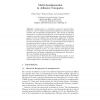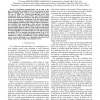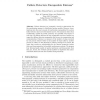717 search results - page 50 / 144 » Kill-safe synchronization abstractions |
GG
2010
Springer
14 years 2 days ago
2010
Springer
Abstract. Amalgamation is a well-known concept for graph transformations in order to model synchronized parallelism of rules with shared subrules and corresponding transformations....
DC
2007
13 years 11 months ago
2007
Abstract Many reliable distributed systems are consensusbased and typically operate under two modes: a fast normal mode in failure-free synchronous periods, and a slower recovery m...
GLOBECOM
2010
IEEE
13 years 9 months ago
2010
IEEE
Abstract-- Cooperative communications can be used to improve communication reliability. However, the transmissions from different relaying nodes result in a great challenge in prac...
ISLPED
2010
ACM
13 years 9 months ago
2010
ACM
Abstract--As a replacement for the fast-fading GloballySynchronous model, we have defined a flexible design style called GRLS, for Globally-Ratiochronous, Locally-Synchronous, whic...
OPODIS
2010
13 years 9 months ago
2010
Failure detectors are commonly viewed as abstractions for the synchronism present in distributed system models. However, investigations into the exact amount of synchronism encapsu...



